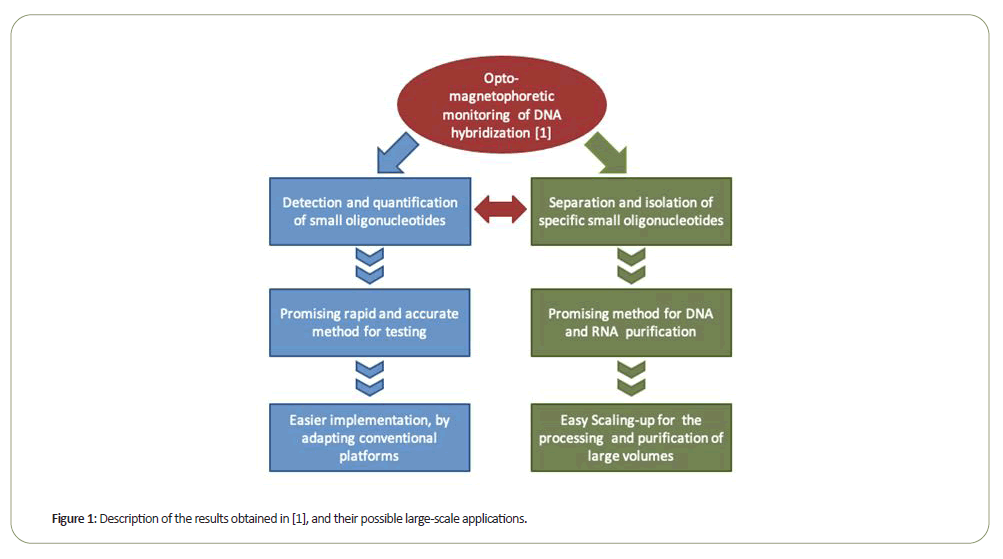Commentary on the Simultaneous Optical and Magnetophoretic Monitoring of DNA Hybridization using Superparamagnetic and Plasmonic Colloids
Maria Benelmekki and Lluis M Martinez
Maria Benelmekki1,2* and Lluis M Martinez2
1 Department of Engineering, Swansea University, Bay Campus, Fabian Way, Swansea, UK
2 Sepmag Tecnologies, Parc Tecnologic del Valles, E-08290 Barcelona, Spain
- *Corresponding Author:
- Maria Benelmekki
College of Engineering,Swansea University,
Bay campus,
Fabian Way,
Swansea,
UK;
E-mail: maria.benelmekki@swansea.ac.uk
Received Date: November 25, 2020; Accepted Date: December 10, 2020; Published Date: December 17, 2020
Citation: Benelmekki M, Martinez LM (2020) Commentary on the Simultaneous Opical and Magnetophoretic Monitoring of DNA Hybridization using Superparamagnetic and Plasmonic Colloids. Insights Med Phys Vol. 5 No. 3: 16.
Description
In our previous work [1], we presented a new method for accurate and rapid detection, and isolation of small oligonucleotides, using superparamagnetic and plasmonic nanoparticles (hereafter MPs). In a brief description of the mentioned work, separate suspensions of MPs functionalized with twenty-mer complementary oligonucleotides were mixed and incubated at different experimental conditions, and therefore, colloidal aggregates composed of the functionalized-MPs were formed as a result of the hybridization of the complementary oligonucleotides [1-3]. When the mixtures were brought under a uniform magnetic field gradient, the formed aggregates moved at a different velocity than the initial non-functionalized-MPs, in response to the applied magnetics force. The separation velocity of the aggregates from the suspensions was optically monitored, leading to accurate information on their magnetic strength [4], and thus allowing the quantification of the hybridized oligonucleotides [1].
In summary, and as illustrated in Figure 1, the advantage of the developed method is twofold [1]: i) It allows an accurate and rapid detection of small biomolecules, together with a relatively easy implementation for population testing, by adapting conventional platforms such as, for example, the latex-agglutination-test platforms; ii) It enables the separation and isolation of target small biomolecules, with the possibility to scale-up the magnetic device used for the MPs separation, and thus allowing to process and separate large volumes of suspensions, while the optical control of the separation process can be simplified using a Light-Emitting- Diode (LED) [2,3]. These findings are a promising step towards a simple quantitative tool for rapid molecular diagnosis of diseases, and might contribute to the improvement of conventional technique, such as the case of Latex-Agglutination-Tests, used to detect a wide range of analytes in clinical laboratories [5,6].
Figure 1: Description of the results obtained in [1], and their possible large-scale applications.
Keeping this in view, this commentary aims to outline how these findings might benefit the urgent needs to control the current COVID-19 pandemic, which has severely impacted the living conditions of billions of people worldwide. In the early months of the crisis, the huge concern was to forecast the future spread of the disease by increasing the capacity of the worldwide health care systems to conduct a massive testing for the global population, and thus to truck and control the transmission of the virus (SARS-CoV-2) causing the COVID-19 pandemic [7,8]. Currently, the preoccupation has relatively shifted towards the massive production of the vaccines against the virus [9]. Accordingly, most of the advanced candidate vaccines are based on mimicking a part of the genetic sequence of the virus in the form of DNA or RNA [10,11], which implies the need of efficient and cost-effective techniques for large volume purification and separation of DNA and RNA.
Hence, the method presented in [1] is a small contribution to the massive efforts energized by the global fight against the COVID-19 pandemic, towards the development of vaccines and tests, together with the acquirement of the know, how to face a 21st century pandemic. In other words, bringing all these efforts together will transform how the world will respond to possible future outbreaks of infectious disease [9,11,12].
Conflict of Interest
Authors have no conflict of interests.
Acknowledgment
The authors thank Dr. Liebana and Dr. Gasso (www. pragmaticdiagnostics.com) for the technical discussions related to Latex-agglutination tests.
References
- Benelmekki M, Gasso S, Martinez LM (2020) Simultaneous optical and magnetophoretic monitoring of DNA hybridization using superparamagnetic and plasmonic colloids. J Coll Surf Biointefaces 193: 111126.
- Opto-magnetophoretic method for the detection of biological and chemical substances. 2019.
- Device and method for separating magnetic particles. 2013.
- Andreu JS, Camacho J, Faraudo J (2011) Aggregation of superparamagnetic colloids in magnetic fields: the quest for the equilibrium state. Soft Matter. 7: 2336-2339.
- Gella FJ, Serra J, Gener J (1991) Latex agglutination procedures in immunodiagnosis. Pure App 63: 1131-1134.
- Pak OS, Pietrzyk K, Ly A, Maldonado-Liu A, Fukuoka S, et al. Quantification of a latex agglutination assay for bacterial pathogen detection in a low-cost capillary-driven fluidic platform. 2016 IEEE Global Humanitarian Technology Conference (GHTC). 765-769.
- Deepy Z (2020) CRISPR/Cas - Prospective Rapid Diagnostic Technique for COVID-19. Adv Appl Sci Res 11: 1-2.
- Chinese Scientists Sequence Genome of COVID-19. 2020.
- Strickland E, Zorpette G (2020) Prepping for the next big one. IEEE Spectrum.
- Draft landscape of COVID-19 candidate vaccines. 2020.
- Waltz E (2020) AI takes its best shot: What AI can-and can't-do in the race for a coronavirus vaccine. IEEE Spectrum 57: 25-27.
- Mujawar MA, Gohel H, Bhardwaj SK, Srinivasan S, Hickman N, et al. (2020) Nano-enabled biosensing systems for intelligent healthcare: towards COVID-19 management. Mat Today Chem. 17: 1003062.
Open Access Journals
- Aquaculture & Veterinary Science
- Chemistry & Chemical Sciences
- Clinical Sciences
- Engineering
- General Science
- Genetics & Molecular Biology
- Health Care & Nursing
- Immunology & Microbiology
- Materials Science
- Mathematics & Physics
- Medical Sciences
- Neurology & Psychiatry
- Oncology & Cancer Science
- Pharmaceutical Sciences

